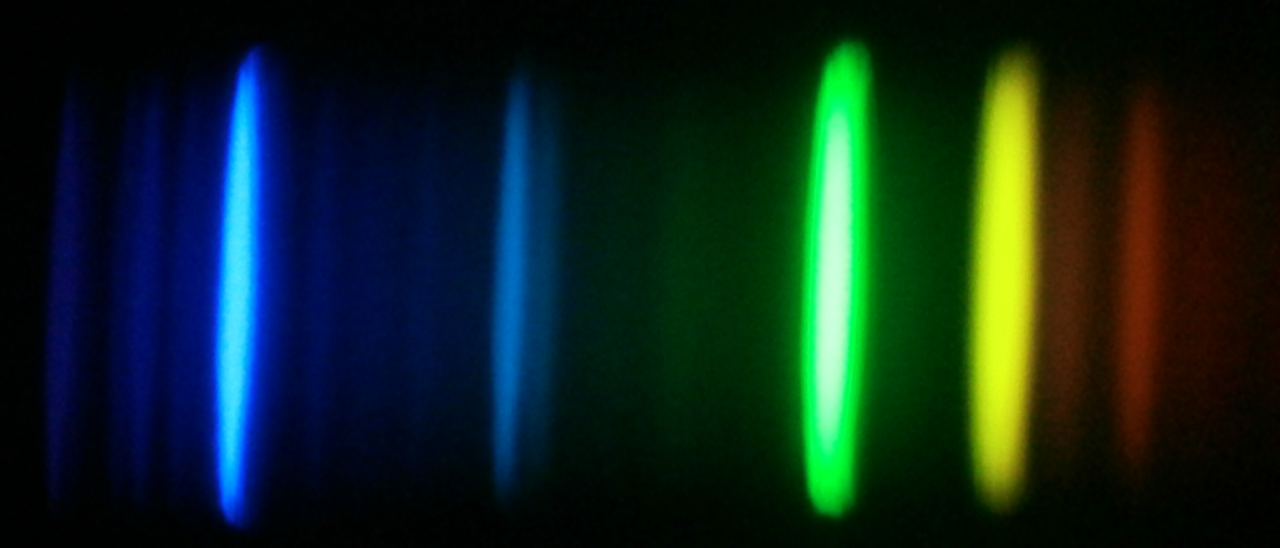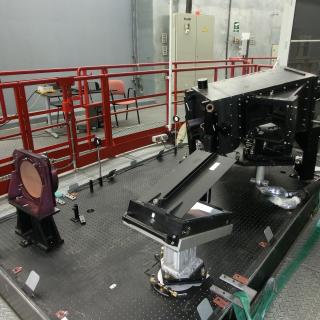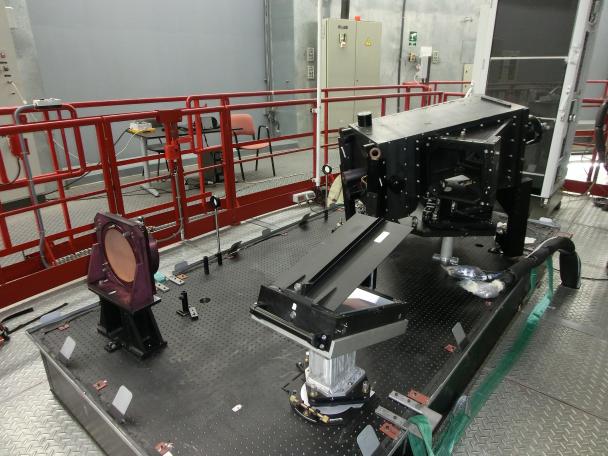Grants related:
General
Stellar spectroscopy allows us to determine the properties and chemical compositions of stars. From this information for stars of different ages in the Milky Way, it is possible to reconstruct the chemical evolution of the Galaxy, as well as the origin of the elements heavier than boron, created mainly in stellar interiors. It is also possible to study stellar formation, and the formation of the Galaxy, from the signature of the Galactic potential on the stellar orbits, and the distributions of mass, ages, and the abundance of heavy elements.
Obtaining high-resolution spectra, as necessary for studies of chemical compositions, requires advanced and efficient instrumentation. This is particularly true for research that calls for large stellar samples, which demands the observation of hundreds or thousands of sources simultaneously. Efficiency requires that the data processing and analysis are performed in an automated way.
The interpretation of spectra is based on physical models of the atmospheres of the stars, from where the light that we observe escapes the stars. The main ingredients for building such models are the fluid dynamics, and the properties of the atoms, ions, and molecules, especially regarding their interactions with the radiation coming from the stellar interior.
Once we have a plausible model, it is possible to compute in detail how the radiation propagates through the stellar atmosphere, and the emergent spectrum, which can then be iteratively compared with the observations to refine the model.
This project covers three different research fronts:
- Improving model atmospheres and simulations of stellar spectra.
- Developing tools for acquisition, reduction, and analysis of spectroscopic observations, in particular for the determination of chemical abundances in stars.
- Designing, preparing, and executing spectroscopic studies of stars aimed at understanding a) the most relevant aspects of the physics of stellar atmospheres, b) the formation and evolution of stars, c) the origin of the chemical elements, and d) the formation, structure, and evolution of the Milky Way galaxy.
Members
Results
- Complete the installation and commissioning of HORuS on GTC
- Discover two new stars with more than 100,000 times less iron than the Sun
- Complete the classification of all the APOGEE spectra with K-means
- Publish a complete collection of model stellar spectra for stars O to M
- Identify the signature of chemical diffusion in the atmospheres of the stars in the cluster M67
Scientific activity
Related publications
-
The Gaia-ESO Survey: processing FLAMES-UVES spectra
The Gaia-ESO Survey is a large public spectroscopic survey that aims to derive radial velocities and fundamental parameters of about 105 Milky Way stars in the field and in clusters. Observations are carried out with the multi-object optical spectrograph FLAMES, using simultaneously the medium-resolution (R ~ 20 000) GIRAFFE spectrograph and the
Sacco, G. G. et al.Advertised on:
52014 -
Chemodynamics of the Milky Way. I. The first year of APOGEE data
Context. The Apache Point Observatory Galactic Evolution Experiment (APOGEE) features the first multi-object high-resolution fiber spectrograph in the near-infrared ever built, thus making the survey unique in its capabilities: APOGEE is able to peer through the dust that obscures stars in the Galactic disc and bulge in the optical wavelength range
Anders, F. et al.Advertised on:
42014 -
The Gaia-ESO Survey: radial metallicity gradients and age-metallicity relation of stars in the Milky Way disk
We study the relationship between age, metallicity, and α-enhancement of FGK stars in the Galactic disk. The results are based upon the analysis of high-resolution UVES spectra from the Gaia-ESO large stellar survey. We explore the limitations of the observed dataset, i.e. the accuracy of stellar parameters and the selection effects that are caused
Bergemann, M. et al.Advertised on:
52014 -
Chemical Cartography with APOGEE: Large-scale Mean Metallicity Maps of the Milky Way Disk
We present Galactic mean metallicity maps derived from the first year of the SDSS-III APOGEE experiment. Mean abundances in different zones of projected Galactocentric radius (0 < R < 15 kpc) at a range of heights above the plane (0 < |z| < 3 kpc), are derived from a sample of nearly 20,000 giant stars with unprecedented coverage, including stars
Hayden, M. R. et al.Advertised on:
52014 -
The SEGUE K Giant Survey. II. A Catalog of Distance Determinations for the SEGUE K Giants in the Galactic Halo
We present an online catalog of distance determinations for 6036 K giants, most of which are members of the Milky Way's stellar halo. Their medium-resolution spectra from the Sloan Digital Sky Survey/Sloan Extension for Galactic Understanding and Exploration are used to derive metallicities and rough gravity estimates, along with radial velocities
Xue, X.-X. et al.Advertised on:
42014 -
Discovery of Two Rare Rigidly Rotating Magnetosphere Stars in the APOGEE Survey
The Apache Point Observatory Galactic Evolution Experiment (APOGEE)—one of the Sloan Digital Sky Survey III programs—is using near-infrared (NIR) spectra of ~100,000 red giant branch star candidates to study the structure of the Milky Way. In the course of the survey, APOGEE also acquires spectra of hot field stars to serve as telluric calibrators
Eikenberry, S. S. et al.Advertised on:
42014 -
The Tenth Data Release of the Sloan Digital Sky Survey: First Spectroscopic Data from the SDSS-III Apache Point Observatory Galactic Evolution Experiment
The Sloan Digital Sky Survey (SDSS) has been in operation since 2000 April. This paper presents the Tenth Public Data Release (DR10) from its current incarnation, SDSS-III. This data release includes the first spectroscopic data from the Apache Point Observatory Galaxy Evolution Experiment (APOGEE), along with spectroscopic data from the Baryon
Anders, Friedrich et al.Advertised on:
42014 -
ESPRESSO: The next European exoplanet hunter
The acronym ESPRESSO stems for Echelle SPectrograph for Rocky Exoplanets and Stable Spectroscopic Observations; this instrument will be the next VLT high resolution spectrograph. The spectrograph will be installed at the Combined-Coudé Laboratory of the VLT and linked to the four 8.2 m Unit Telescopes (UT) through four optical Coudé trains
Santos, N. C. et al.Advertised on:
12014 -
Identification of red supergiants in nearby galaxies with mid-IR photometry
Context. The role of episodic mass loss in massive-star evolution is one of the most important open questions of current stellar evolution theory. Episodic mass loss produces dust and therefore causes evolved massive stars to be very luminous in the mid-infrared and dim at optical wavelengths. Aims: We aim to increase the number of investigated
Morrell, N. I. et al.Advertised on:
22014 -
New Red Jewels in Coma Berenices
We have used Sloan Digital Sky Survey-III (SDSS-III) Apache Point Observatory Galactic Evolution Experiment (APOGEE) radial velocity observations in the near-infrared H-band to explore the membership of the nearby (86.7 ± 0.9 pc) open cluster Coma Berenices (Melotte 111), concentrating on the poorly populated low-mass end of the main sequence
Wilson, John C. et al.Advertised on:
22014 -
Doppler imaging of the double-lined active binary V824 Ara
We introduce an iterative spectral disentangling technique combined with Doppler imaging in order to recover surface temperature maps for both components of double-lined active binary systems. Our method provides an opportunity to separate spectra of the active components while minimizing the unwanted disturbances on the given line profile from the
García-Alvarez, D. et al.Advertised on:
112013 -
Hypervelocity Star Candidates in the SEGUE G and K Dwarf Sample
We present 20 candidate hypervelocity stars from the Sloan Extension for Galactic Understanding and Exploration (SEGUE) G and K dwarf samples. Previous searches for hypervelocity stars have only focused on large radial velocities; in this study, we also use proper motions to select the candidates. We determine the hypervelocity likelihood of each
Schneider, Donald P. et al.Advertised on:
12014 -
RATS-Kepler - a deep high-cadence survey of the Kepler field
We outline the purpose, strategy and first results of a deep, high-cadence, photometric survey of the Kepler field using the Isaac Newton Telescope on La Palma and the MDM 1.3 m Telescope on Kitt Peak. Our goal was to identify sources located in the Kepler field of view which are variable on a time-scale of a few minutes to 1 h. The astrophysically
Still, Martin et al.Advertised on:
12014 -
Infrared Laboratory Oscillator Strengths of Fe I in the H-band
We report experimental oscillator strengths for 28 infrared Fe I transitions, for which no previous experimental values exist. These transitions were selected to address an urgent need for oscillator strengths of lines in the H-band (between 1.4 μm and 1.7 μm) required for the analysis of spectra obtained from the Sloan Digital Sky Survey (SDSS-III
Ruffoni, M. P. et al.Advertised on:
122013 -
The SDSS-III APOGEE Radial Velocity Survey of M Dwarfs. I. Description of the Survey and Science Goals
We are carrying out a large ancillary program with the Sloan Digital Sky Survey, SDSS-III, using the fiber-fed multi-object near-infrared APOGEE spectrograph, to obtain high-resolution H-band spectra of more than 1200 M dwarfs. These observations will be used to measure spectroscopic rotational velocities, radial velocities, physical stellar
Deshpande, R. et al.Advertised on:
122013 -
Discovery of a Dynamical Cold Point in the Heart of the Sagittarius dSph Galaxy with Observations from the APOGEE Project
The dynamics of the core of the Sagittarius (Sgr) dwarf spheroidal (dSph) galaxy are explored using high-resolution (R ~ 22, 500), H-band, near-infrared spectra of over 1000 giant stars in the central 3 deg2 of the system, of which 328 are identified as Sgr members. These data, among some of the earliest observations from the Sloan Digital Sky
Majewski, Steven R. et al.Advertised on:
112013 -
Calibrations of Atmospheric Parameters Obtained from the First Year of SDSS-III APOGEE Observations
The Sloan Digital Sky Survey III (SDSS-III) Apache Point Observatory Galactic Evolution Experiment (APOGEE) is a three-year survey that is collecting 105 high-resolution spectra in the near-IR across multiple Galactic populations. To derive stellar parameters and chemical compositions from this massive data set, the APOGEE Stellar Parameters and
Chaplin, W. J. et al.Advertised on:
112013 -
The Open Cluster Chemical Analysis and Mapping Survey: Local Galactic Metallicity Gradient with APOGEE Using SDSS DR10
The Open Cluster Chemical Analysis and Mapping (OCCAM) survey aims to produce a comprehensive, uniform, infrared-based data set for hundreds of open clusters, and constrain key Galactic dynamical and chemical parameters from this sample. This first contribution from the OCCAM survey presents analysis of 141 members stars in 28 open clusters with
Wilson, John C. et al.Advertised on:
112013 -
The Protoplanetary Disks in the Nearby Massive Star-forming Region Cygnus OB2
The formation of stars in massive clusters is one of the main modes of the star formation process. However, the study of massive star-forming regions is hampered by their typically large distances to the Sun. One exception to this is the massive star-forming region Cygnus OB2 in the Cygnus X region, at the distance of ~1400 pc. Cygnus OB2 hosts
Guarcello, M. G. et al.Advertised on:
82013 -
Very Low Mass Stellar and Substellar Companions to Solar-like Stars from MARVELS. IV. A Candidate Brown Dwarf or Low-mass Stellar Companion to HIP 67526
We report the discovery of a candidate brown dwarf (BD) or a very low mass stellar companion (MARVELS-5b) to the star HIP 67526 from the Multi-object Apache point observatory Radial Velocity Exoplanet Large-area Survey (MARVELS). The radial velocity curve for this object contains 31 epochs spread over 2.5 yr. Our Keplerian fit, using a Markov Chain
Jiang, P. et al.Advertised on:
92013
Related talks
No related talks were found.Related conferences
No related conferences were found.News

The IAC is an internationalized Spanish research centre aiming to achieve major advances in the understanding of the laws that govern the origin and evolution of the various forms of matter/energy in the Universe. Outstanding results are expected in key areas of research such as Solar physics, Sun-Earth connections, Exoplanetary systems, Solar







